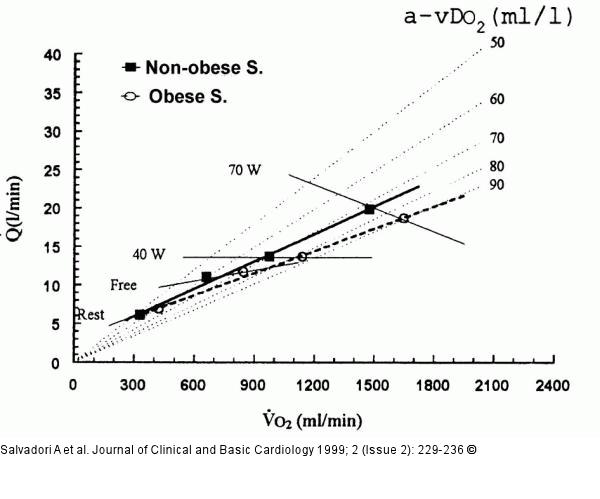Salvadori A, Arreghini M, Bolla G, Fanari P, Giacomotti E, Longhini E, Miserocchi G, Palmulli P Cardiovascular and adrenergic response to exercise in obese subjects Journal of Clinical and Basic Cardiology 1999; 2 (2): 229-236 PDF Summary Overview
| ||||||||||||||||||
Figure/Graphic 6: Cardiac Output - Sauerstoffverbrauch - Adipositas Cardiac output (Q·) vs. oxygen consumption (V·O2) in nonobese and obese subjects with increasing workload. Also shown are iso-workload and iso-arterio-venous oxygen difference lines (a-vDO2). The regression was: Q· = 2.414 + 0.01 V·O2 + 0.494Z - 0.0021 V·O2Z (R²: 0.83; F: 133; MSE: 4.5), with a dummy variable Z = 1 for the obese and 0 for the non-obese subjects. The regression for obese subjects displays a significantly lower slope compared to controls (p < 0.05). |

Figure/Graphic 6: Cardiac Output - Sauerstoffverbrauch - Adipositas
Cardiac output (Q·) vs. oxygen consumption (V·O2) in nonobese and obese subjects with increasing workload. Also shown are iso-workload and iso-arterio-venous oxygen difference lines (a-vDO2). The regression was: Q· = 2.414 + 0.01 V·O2 + 0.494Z - 0.0021 V·O2Z (R²: 0.83; F: 133; MSE: 4.5), with a dummy variable Z = 1 for the obese and 0 for the non-obese subjects. The regression for obese subjects displays a significantly lower slope compared to controls (p < 0.05). |








